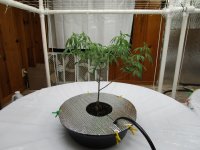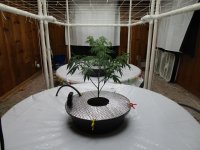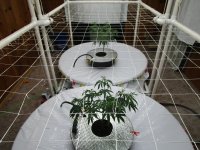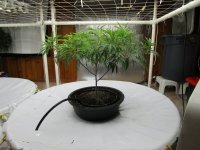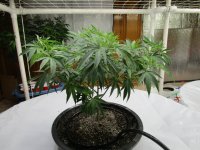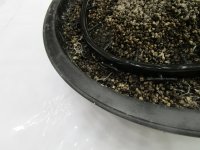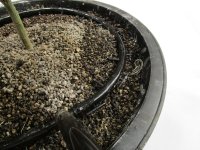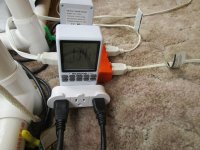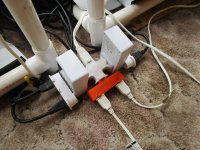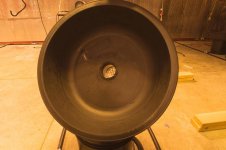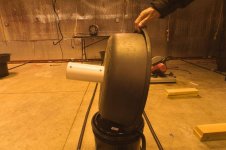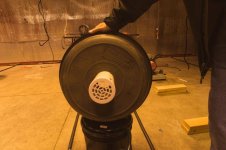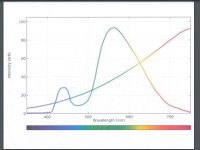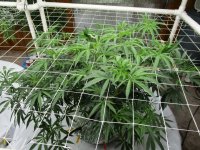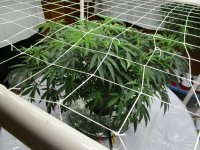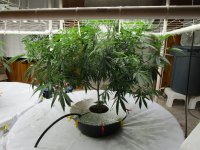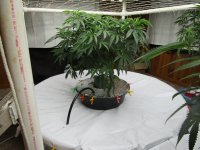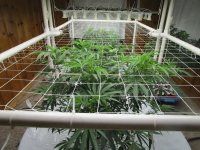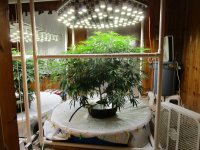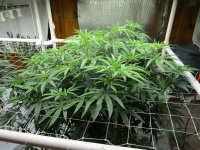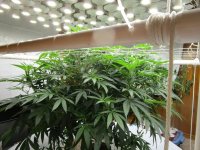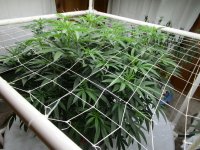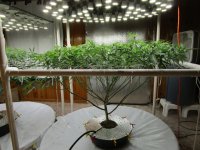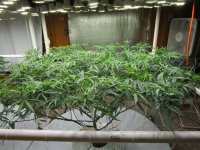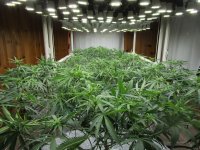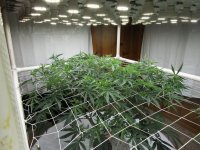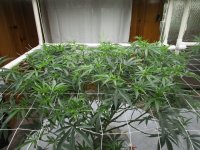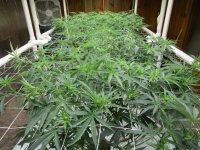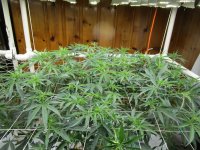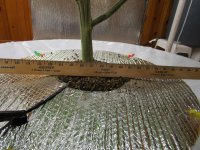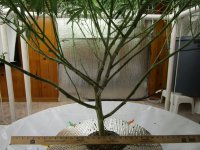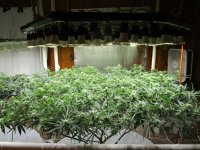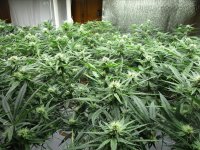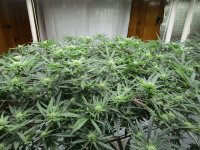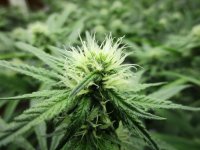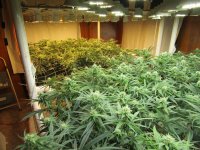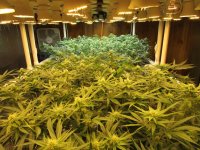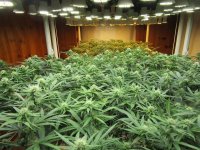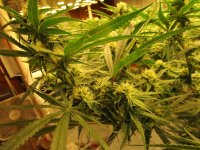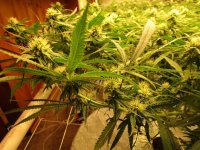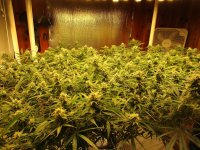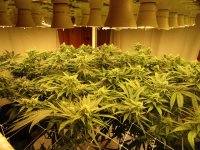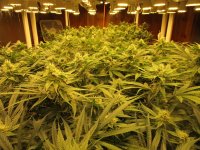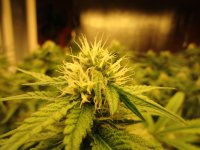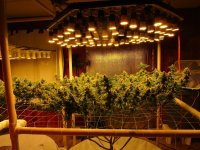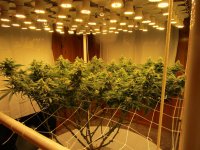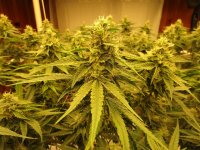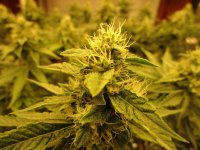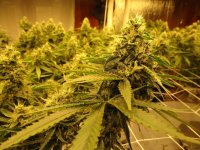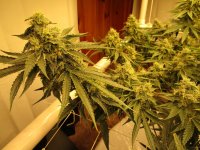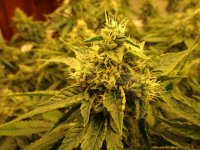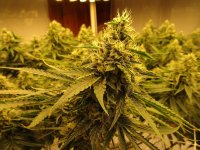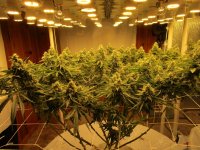Your system is totally impressive greyfader. It's like the Photo of the Month winner - I just look at it and think "Wow".
thank you so much for the kind words! The PPK system was invented by my alter ego, Delta9nxs. i had been growing for 13 years by 2009, all hydro. trying every type of system out there except for aeroponics. they all had flaws. the roots in the water types, like dwc, rdwc, undercurrent, bio-buckets, etc. could kill your crop rapidly in the case of power failures and were critically dependent on solution temperature control to maintain adequate o2 levels and aeration. EC and PH drifting all over the place needing constant correction. they all required heavy continuous movement of water with water or air pumps running all the time. NFT has serious problems with hydro slime and needs pumps running full time. flood and drain where the roots are out of the solution and temporarily submerged is the most reliable but has problems with flooding and draining through the same constricted plumbing. in this device, nothing happens when the power or pumps fail. the tube back feeds the plant via capillary rise. it just won't grow as fast as it does with the power on. you can still hand-water the plants from the reservoir for while to maintain circulation but don't have to.
I had a liver transplant in 2009, and while recovering in the hospital I had one of those epiphanic moments. I realized that some of the roots could be continuously submerged and won't drown if most of the roots were not in the solution. you could have a 24/7 hydraulic connection to the reservoir full of water and nutrients, and by keeping most of the roots in the medium out of the solution, massive amounts of o2 as well.
I did the math one time and if you take two identical containers, one full of water and one full of ambient air, at sea level and 68F, the one full of air will have 23,300 times more free o2 molecules than the water-filled container.
another aspect of this is that to get enough free O2 molecules in the water container you must run it at cool temperatures like 68F or get root rot because the solution will become anaerobic if you don't. temperature is the second most powerful regulator of plant growth after light. in this device, temperature doesn't matter because you are deriving O2 from ambient air, not water. the solution could be totally anaerobic and the plant will grow just fine. so warm water temperatures are desirable. my reservoirs in this grow run around 78-82F and are not aerated. no airstones, no continuously running pumps. because of the indifference to temperature, it is the only recirculating closed circuit system that will work just fine outdoors in 100F heat. if you are not putting a bio-demand on the solution for O2 it will naturally stay aerobic because of atmospheric partial pressures.
airstones can wreak havoc with PH especially if you are running co2 because they inject co2 into the solution where it becomes carbonic acid and radically drops PH. it's okay if you factor it in while adjusting PH to the desired level but as soon as the power goes off it reverses and PH shoots upward.
i started out with passive wick fed via a tube like you see here and it worked fine and grew beautiful but small plants. but when I started top watering by hand regularly in addition to sub-irrigating via the wick the plants got significantly larger faster.
so then I went to timed, pulsed, top watering by pumps in addition to the sub-irrigation and things blew up. by pulsed I mean not a steady drip but putting a slug of solution out in a short time frame then stopping until the next event. in this grow I get 1/2 gal in 15 seconds every two hours. pumps on 3 minutes per day. gravity propels the slug of water through the root zone like a piston in an engine.
i realized a steady drip creates a splash zone on the surface but then tends to reform into a column sub-surface propelled by gravity and can channel through the medium instead of spreading creating wet and dry zones.
microscopically, water resists going into dry and jumps to wet. By keeping the medium in a nearly perfect balance of wet and air-filled porosity you can create an almost perfect interface of water, nutrients, air, and roots.
you never let the medium dry down. the tube positively drains the perched water table that occurs in conventional pots immediately after watering. in the conventional pot, you must wait for the medium to dry down before watering again or you will drown the plant. because we can eliminate the perched water table there are no restrictions on watering if you use a porous medium.
the frequent watering corrects root zone EC and PH on every pass, it also introduces fresh O2 and expells old gases. it disrupts the naturally forming water retention curve that forms after watering a plant once the medium drains to the point where gravity stops and the perched water table forms, the retention curve is drier at the top and wetter at the bottom. by disrupting it frequently you are keeping a better moisture profile and roots grow equally throughout the medium, taking more advantage of pot space. in a purely top-watered container nutrient salts accumulate in the bottom of the container. in a purely bottom-watered container, the salts accumulate in the top of the container. salt accumulation causes pH drift and nutrient imbalance within the container. in this device, there is no accumulation and the salts stay in solution.
i have been using this system for 14 years and have been refining it and simplifying it. It virtually operates itself. all I do is check to make sure the feed tank doesn't run dry although you can let it do so for a while if you want to. you can use the elevated mixing tank to steer the solution and control both the PH and EC in the recirculating part of the system.
you will harvest every plant you put in it if you don't get bugs.
I began growing because I was sick and could not get high-quality medicine unless I produced it myself. I could have patented the idea and sold it to some big corporation but I decided to give it away so that folks could easily and reliably grow their own medicine. It is not a specific build but rather a flow pattern that can be built in any size. I have a friend who grows in a little armoire using the idea and I have plumbed out 10k sq ft warehouses with it. i had a 3500 sq ft facility in Oregon for 5 years producing 2.5 to 3.5 lb plants. I just turned 73 yesterday and no longer grow commercially personally but function as a consultant. i have helped set up giant greenhouses and open-field operations using the flow pattern. one time we used a big concrete pad where a building had burned down. no dirt to use. it works in desert conditions where the soil is too alkaline and there is not much water.
well, enough for now! i don't mind answering questions and enjoy helping people grow. later
